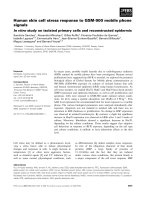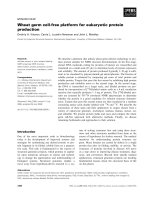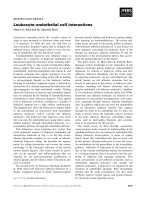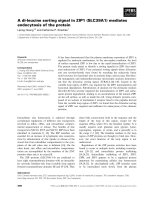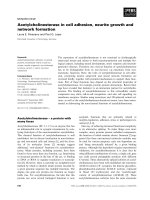báo cáo khoa học: "Non-destructive on-chip cell sorting system with real-time microscopic image processing" pptx
Bạn đang xem bản rút gọn của tài liệu. Xem và tải ngay bản đầy đủ của tài liệu tại đây (892.56 KB, 8 trang )
BioMed Central
Page 1 of 8
(page number not for citation purposes)
Journal of Nanobiotechnology
Open Access
Research
Non-destructive on-chip cell sorting system with real-time
microscopic image processing
Kazunori Takahashi
1
, Akihiro Hattori
1,2
, Ikurou Suzuki
1
, Takanori Ichiki
3,4
and Kenji Yasuda*
1
Address:
1
Department of Life Sciences, Graduate school of Arts and Sciences, University of Tokyo, 3-8-1 Komaba, Meguro, Tokyo 153-8902 JAPAN,
2
Systems Products Division, Sigma Koki, Co. Ltd., 17-2 Shimo-takahagi-shinden, Kawagoe, Saitama 350-1297 JAPAN,
3
Department of Electrical
& Electronics Engineering, Faculty of Engineering, Toyo University, 2100 Kujirai, Kawagoe, Saitama 350-8585 JAPAN and
4
General Research
Center, Graduate School of Engineering, University of Tokyo, 2-11-16 Yayoi, Bunkyo, Tokyo 113-8656 JAPAN
Email: Kazunori Takahashi - ; Akihiro Hattori - ;
Ikurou Suzuki - ; Takanori Ichiki - ; Kenji Yasuda* -
* Corresponding author
Abstract
Studying cell functions for cellomics studies often requires the use of purified individual cells from
mixtures of various kinds of cells. We have developed a new non-destructive on-chip cell sorting
system for single cell based cultivation, by exploiting the advantage of microfluidics and electrostatic
force. The system consists of the following two parts: a cell sorting chip made of poly-
dimethylsiloxane (PDMS) on a 0.2-mm-thick glass slide, and an image analysis system with a phase-
contrast/fluorescence microscope. The unique features of our system include (i) identification of a
target from sample cells is achieved by comparison of the 0.2-µm-resolution phase-contrast and
fluorescence images of cells in the microchannel every 1/30 s; (ii) non-destructive sorting of target
cells in a laminar flow by application of electrostatic repulsion force for removing unrequited cells
from the one laminar flow to the other; (iii) the use of agar gel for electrodes in order to minimize
the effect on cells by electrochemical reactions of electrodes, and (iv) pre-filter, which was
fabricated within the channel for removal of dust contained in a sample solution from tissue
extracts. The sorting chip is capable of continuous operation and we have purified more than ten
thousand cells for cultivation without damaging them. Our design has proved to be very efficient
and suitable for the routine use in cell purification experiments.
Background
Developing of a cell based screening assay often requires
identification and isolation of particular cells from a mix-
ture of various kinds of cells. Moreover, in order to obtain
reproducible data on cells, reliable and non-destructive
purification of cells is essential. Efficient and rapid sorting
of cells has been accomplished with techniques such as
fluorescence-activated cell sorting (FACS) [1], magnetic-
activated cell separation (MACS), automated single-cell
sorting using dual-beam optical trapping, differential
adhesion cell sorting [2], and micro-fabricated fluores-
cence-activated cell sorting [3]. These conventional cell
sorters can be used for purification of individual cells, but
are not ideal techniques and have a number of disadvan-
tages For example, FACS can damage cells during
destructive droplet generation, and the detection (based
on the non-direct scattering) has poor cell recognition
performance. Other conventional techniques also have
Published: 03 June 2004
Journal of Nanobiotechnology 2004, 2:5
Received: 13 December 2003
Accepted: 03 June 2004
This article is available from: />© 2004 Takahashi et al; licensee BioMed Central Ltd. This is an Open Access article: verbatim copying and redistribution of this article are permitted in all
media for any purpose, provided this notice is preserved along with the article's original URL.
Journal of Nanobiotechnology 2004, 2 />Page 2 of 8
(page number not for citation purposes)
disadvantages with regard to their cost, efficiency,
response speed, separate resolution, and adaptability. Fur-
thermore, if cells are to be cultivated after subsequent sort-
ing, the damage to cells caused by to the sorting process
should be minimized. Advantages offered by application
of microfluidics include reduced sample volumes and
reaction times, lowered space requirements and opera-
tional costs [4]. In micro- and nano-technology liquid
flow is mostly laminar and this further facilitates making
microscopic sorting devises for biomedical applications.
We have developed new on-chip microfluidic cell sorting
system, which overcomes problems associated with the
conventional cell sorting techniques. Our system directly
monitors and recognizes cells with specific index using
phase-contrast/fluorescence microscopy and image
processing, and it can rapidly and safely sort them accord-
ing to the index (shape, and spatial distribution of fluores-
cent dye of the specific antibody marker, and so on) in a
laminar flow using the electrostatic force. The electric
force is applied only to the cells which have to be removed
to waste; the target cells simply flow down the laminar
flow and do not receive any stimulation from non-contact
forces. In this paper, we explain the design of the on-chip
cell sorter system and give the results of an experimental
implementation of our design.
Results and Discussion
Design of on-chip cell sorting system
As shown in Figure 1(a), this system consists of the fol-
lowing four parts: disposable cell-sorter chip, optical
microscope equipped with phase-contrast/fluorescence
image processing module, charge-coupled device (CCD)
camera with image intensifier, personal computer with
image processing software for cell recognition and sorting
control. Figure 1(b) shows the schematic drawing of the
disposable cell-sorter chip. The chip was made of poly-
dimethylsiloxane (PDMS) [5-8] attached to a thin glass
slide. Microfluidic channels and gel electrodes are fabri-
cated within the PDMS structure by moulding the thick
photo-resist microstructure. We have chosen PDMS so we
could make replicas of the microfluidic channels within 1
hour by using a simple moulding process.
Figure 2 also shows the detailed cross-section view of the
cell sorter chip and the microfluidic channels. The design
includes two symmetric flow channels for passing sample
solution and liquid buffer. They form the junction at the
centre of the chip (cell sorting area) where two laminar
flows from the two channels meet. At this boundary (see
A-A' section in Fig. 2), cells in the sample solution flow
can be transported to the other buffer flow by electrostatic
force. Importantly, the voltage is only applied for
The design of cell sorting systemFigure 1
The design of cell sorting system (a) schematic view of the cell sorter system. (b) schematic view of on-chip cell sorter.
Journal of Nanobiotechnology 2004, 2 />Page 3 of 8
(page number not for citation purposes)
removing the undesired cells from the sample. In this sort-
ing area, two wide channels filled with agarose gel elec-
trodes are connected to the flow channels with narrow
channels filled with electrolyte. The agarose gel electrodes
are made of 1% agarose (Sigma, Agarose Type2-A, MO,
USA) and 1-M NaCl as electrolyte.
Cell sorter chip design and process
The process of the cell sorter chip fabrication is shown in
Figure 3. First, the microfluidic channel for transportation
of cells is fabricated with a mould made of thick negative
photo-resist, SU-8-25 (viscosity of which is optimised for
25-µm-thick photo-resist layer: Microlithography Chemi-
cal Corp., Newton, MA, U.S.A.). After development of the
25-µm-thick SU-8 microstructure on a glass plate, the
master is baked at 200°C for better adhesion between
Whole structure of on-chip cell sorterFigure 2
Whole structure of on-chip cell sorter.
Journal of Nanobiotechnology 2004, 2 />Page 4 of 8
(page number not for citation purposes)
glass and SU-8 pattern. Next, a 10:1 mixture of silicon
elastomer base (PDMS pre-polymer) and curing agent
(Sylgard 185, Dow Corning, Midland, MI, U.S.A.) is
poured onto the master and cured for 1 h at 75°C. After
curing, the PDMS replica is peeled from the master and is
oxidized with a plasma cleaner (Compact etcher FA-1,
Samco international research centre, Kyoto, Japan) for 30
sec. at 55 W. Subsequently the oxidized replica is attached
to a glass slide as soon as possible. Firm attachment
between them is completed with this simple method.
Inside the channels, sample liquid or agarose gel are
injected by application of air pressure.
Principle of sorting procedure
Figure 4 shows the cell sorting process using our non-
destructive cell sorting system. When the target cell
reaches the sorting area, no voltage is applied to gel elec-
trodes and the cell passes through this area within the
same laminar flow (Figure 4 (a)). When the other unde-
sired cell reaches the sorting area, a DC voltage (up to 10
V) is applied to the gel electrodes to generate an electro-
static force and the cells is transported to the other lami-
nar flow. The direction of cell's transportation depends on
the combination of the electrostatic force and Stokes' vis-
cous drug (Figure 4).
Figure 5 shows an example of sorting process using COS
cells. When no voltage is applied, COS cell flowed straight
down the same channel (Fig 5(a)). However, when volt-
age was applied, COS cells smoothly shifted from the
sample channel to the waste channel (Fig 5(b)). In this
experiment, the applied voltage and current were 15 V and
25 µA, respectively.
The process for fabrication of on-chip cell sorterFigure 3
The process for fabrication of on-chip cell sorter.
Journal of Nanobiotechnology 2004, 2 />Page 5 of 8
(page number not for citation purposes)
Our cell sorting system differs form other available sys-
tems in that only the cells, which have to be removed,
were affected by the electrostatic force. The target cells had
no force applied and therefore had minimal or no damage
done to them. Moreover, the area of the electric field is
limited to the cell sorting area, because the electric current
flows only between the two gel electrodes. Thus cells out
of the area receive no significant damage from the electric
stimulation.
Installation of phase-contrast image recognition into the
sorting system
The phase-contrast image of cells is analysed using the
image processing module and computer. 100× magnifica-
tion objective lens was used for recognition of the fine
structures of cells. Figure 6 shows the one example of the
phase-contrast/fluorescent image of a COS cell within the
pathway. As shown in the figure, we can distinguish the
shape and distribution of cell component within the cell
by non-destructive fluorescent staining. The high-resolu-
tion image was accomplished by the use of the 0.2-mm
thin glass slide at the bottom of the chip, which is within
the working distance of the objective lens. Thus using
these processed images acquired by optical microscope,
we can decide whether the cell should be kept or removed,
and therefore and whether to apply the DC voltage, which
can be done within 1/30 s using our analysis program run-
ning in the personal computer. It should be noted that the
1/30 s resolution is only limited by the resolution of video
frame interval and can be improved up to 1/200 s resolu-
tion using the same system equipped with the camera
capable of capturing 200 images per second.
Composition of agar-gel for low resistance electrode
As explained above, DC voltage is applied into the sorting
area for generation of electrostatic force as driving force of
Principle of our cell sorting methodFigure 4
Principle of our cell sorting method. (a) without DC voltage irradiation: sample cells flow down within the central laminar
flow, (b) with DC voltage (up to 15 V) application: cells move from sample channel into the opposite side of channel connected
to waste channel by resultant force of electrostatic force and laminar flow.
Journal of Nanobiotechnology 2004, 2 />Page 6 of 8
(page number not for citation purposes)
cells' shift from one flow to the other. Although applica-
tion of high voltage between a pair of agar-gel electrodes
forms high electric field enough to transport cells, it heats
the agarose gel electrodes. The melting point of agarose
gel is about 80°C. Thus application of excessive voltage
causes malfunction of the agarose gel electrode. Agarose
gel composition is critical in reducing the resistance and
therefore the heat generation. Figure 7 shows the resist-
ances (Ω/mm
3
) of 1% agar electrode containing various
kinds of electrolytes NaCl, KCl, CuSO
4
, and without elec-
trolyte measured by impedance analyser (Agilent 4294A,
Agilent Technologies Japan, Hyogo, Japan). The concen-
tration of these electrolytes is 1 M each. Although agar-gel
containing CuSO
4
has lowest resistance, we chose NaCl as
the electrolyte because we think low impact to cells in
chemical environment should have priority to anything
else. Importantly, ions such as Na+ and Cl- do not stimu-
late cells unlike other ions such as Cu
2+
, K
+
, Ca
2+
or Mg
2+
.
Also, 1% agarose containing highly ionic strength electro-
lytes such as MgSO
4
, CaCO
3
or ZnSO
4
is difficult to set at
room temperature.
Micrograph image of sorting COS cellsFigure 5
Micrograph image of sorting COS cells. A series of (a-
1, 2, 3) with DC voltage application, a series of (b-1, 2, 3)
without voltage application.
Micrograph of COS cells in the chip pathwayFigure 6
Micrograph of COS cells in the chip pathway.
Electrolyte dependence of 1% agar gel resistances (Ω/mm
3
)Figure 7
Electrolyte dependence of 1% agar gel resistances (Ω/mm
3
).
Journal of Nanobiotechnology 2004, 2 />Page 7 of 8
(page number not for citation purposes)
Construction of filter for purification of cells and removal
of dust in the sample
When sample liquid flows in a narrow channel minute
dust particles or aggregates of dead cells may block the
channel. Therefore, such dust and similar particles must
be removed from the sample solution. We have therefore
added a filter structure into the sample buffer channel.
Figure 8(a) shows the schematic drawing of structure of
the filter. It consists of several pieces of micro-sized poles
fabricated inside the PDMS microstructure. The spacing
between the poles (ca. 15 µm) allows capturing most dust
particles. Figure 8(b) illustrates the efficiency of this filter.
Only dust particles were trapped by this filter structure.
Sorting accuracy of the on-chip cell sorter system
Although the target cell does not receive an electric dam-
age, application of lower voltage is preferred if a portable,
cost-effective sorting system is sought. Figure 9 summa-
rises how the accuracy of cell sorting depends on the volt-
age applied. In the graph, each data was an average of 5
sets of samples. Figure 9 illustrates that 100% accuracy can
be achieved by applying 6 V to the electrodes.
Conclusions
We have developed anon-chip cell sorting system that can
separate target cells mildly and reliably using our original
method and bio-compatible materials, such as agarose gel
that is used as the electrode for the generation of
electrostatic force in the flow channel. Cell sorting is
based on the image analysis processed automatically by
The structure of micro-sized filter in the channelFigure 8
The structure of micro-sized filter in the channel. (a) micrograph of the actual use of the filter and (b) schematic view of
it.
Sorting reliability against applied voltage intensityFigure 9
Sorting reliability against applied voltage intensity.
Publish with BioMed Central and every
scientist can read your work free of charge
"BioMed Central will be the most significant development for
disseminating the results of biomedical research in our lifetime."
Sir Paul Nurse, Cancer Research UK
Your research papers will be:
available free of charge to the entire biomedical community
peer reviewed and published immediately upon acceptance
cited in PubMed and archived on PubMed Central
yours — you keep the copyright
Submit your manuscript here:
/>BioMedcentral
Journal of Nanobiotechnology 2004, 2 />Page 8 of 8
(page number not for citation purposes)
computer. A micro-sized filter for a dust-free flow is fabri-
cated in order to purify sample cells and avoid blocking of
the channels by dust particles. Using our system we have
achieved 100% accurate sorting. We plan to extend our
approach to single cell analysis and regenerative
medicine.
Authors' contributions
KT carried out the microchamber design, cell preparation,
measurement of cell sorter performance, and image anal-
ysis. AK developed the image processing software. IS car-
ried out the microchamber design and cell preparation. TI
and KY conceived of the study, and participated in its
design and coordination. All authors read and approved
the final manuscript.
Acknowledgements
Financial support, in part by the Japan Science and Technology Organization
(JST) and by Grants-in-Aids for Science Research from the Ministry of Edu-
cation, Science and Culture of Japan, is gratefully acknowledged.
References
1. Bonner WA, Hulett HR, Sweet RG: Fluorescence activated cell
sorting. Rev Sci Instrument 1972, 43:404-409.
2. Steinberg M: Reconstruction of tissues by dissociated cells. Sci-
ence 1963, 141:401-408.
3. Fu AY, et al.: A microfabricated fluorescence-activated cell
sorter. Nature Biotech 1999, 17:1109-1111.
4. Barry R, Ivanov D: Microfluidics in Biotechnology. J
Nanobiotechnology 2004, 2:2.
5. Qin D, Xia Y, Whitesides GM: A rapid prototyping method for
generating patterns and structures with feature sizes larger
than 20 µm. Adv Mater 1996, 8:917-919.
6. Duffy DC, McDonald JC, Schueller OJA, Whitesides GM: Rapid pro-
totyping microfluidics systems in poly(dimetylsiloxane). Anal
Chem 1998, 70:4974-4984.
7. Xia Y, Whitesides GM: Soft lithography. Angew Chem Int Ed Engl
1998, 37:550-575.
8. Jackman RJ, Duffy DC, Ostuni E, Willmore ND, Whitesides GM: Fab-
ricating large arrays of microwells with arbitrary dimensions
and filling them using discontinuous dewetting. Anal Chem
1998, 70:2280-2287.



